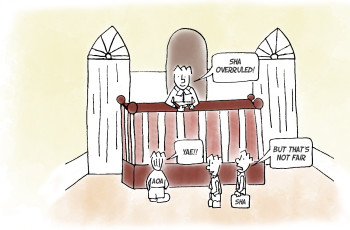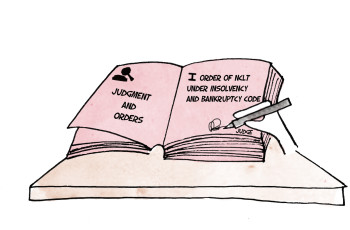Winding up of Companies
The Insolvency and bankruptcy Code, 2016 (‘Code’) inter-alia deals with the corporate and individual insolvency process. The objective of the code is to “consolidate and amend the laws relating to reorganization and insolvency resolution of corporate persons, partnership firms and individuals in a time bound manner for maximization of value of assets of such persons, to promote entrepreneurship, availability of credit and balance of interests of all the stakeholders including alteration in the order of priority of payment of government dues and to establish an Insolvency and Bankruptcy Board of India and for matters connected therewith or incidental thereto”. The Code. The Code is divided into 5 Parts, comprising of 255 Sections and 8 Schedules. Whereas Part II of the Code inter-alia deals with ‘Corporate Insolvency and Liquidation for Corporate Persons’.
Winding of companies vis-à-vis the erstwhile Companies Act:
A Company can be wound up either voluntarily or by the Court as per the provisions of the erstwhile Companies Act, 1956. Section 433 of the Companies Act, 1956 inter-alia provides the circumstances in which a Company may be wound up by the Court 1. One among the various situations in which a Company may be wound up by the Court was if the company is unable to pay its debts. A Company shall be deemed to be unable to pay its debts if there was default on payment of One Lakh Rupees after a demand notice was served by the Creditor. Thereafter on default by the Company, the Creditor can file a petition for winding-up of the Company. On admission of the Petition, the Court adjudicates the Creditors claim to winding up the Company. Once a Winding up Order is issued by the Court, an official liquidator is appointed by the Court who takes over the affairs of the Company and administers it. The liquidator sells the Assets and satisfies the Liabilities of the Company. The Court shall pass a final order to liquidate the Company once the Liquidator settles all the claims of the Company.
Winding up of Companies vis-à-vis the Code:
Section 270 of the Companies Act, 2013 (‘Act’) inter-alia specifies two modes for winding up of Companies i.e. by the Tribunal or Voluntarily. However, the Eleventh Schedule of the Code modifies certain provisions of the Act. By virtue of the modification, a Company cannot be wound u Voluntarily as per the provisions of the Act in relation to winding up. But rather the Provisions of the Code in relation to Voluntary Winding up shall come into play. Further, the provision of the Act in relation to winding up of Companies shall not apply if the Company is unable to pay its debts. Now, if the Company is unable to pay its debts then the provisions of the Code in relation to winding up of companies shall come into play. The National Company Law Tribunal (‘Tribunal’) has been vested with powers to adjudicate Winding up petitions.
Winding up Process under the Code:
- The Code permits 2 a financial creditor, an operational creditor or the corporate debtor by itself to initiate corporate insolvency resolution process. Further, the provisions of the Code shall apply where the minimum value of the default is One Lakh Rupees.
- A financial creditor may by filing an application before the Tribunal can initiate corporate insolvency resolution process.
- An operational creditor shall on the occurrence of a default, deliver a demand notice of unpaid operational debt along with an invoice demanding payment of the amount involved in the default to the corporate debtor. Thereafter, the operational debtor shall within ten days either repay the operational debt or shall bring to the notice of the operational creditor existence of a dispute (if any) and record of the pendency of the suit or arbitration proceedings filed before the receipt of such notice or invoice in relation to such dispute. On failure to pay the operational debt within the period of ten days, the operational creditor may file an application before the Tribunal for initiating a corporate insolvency resolution process.
- A corporate debtor may itself make an application on an occurrence of default before the Tribunal for initiating a corporate insolvency resolution process.
- On Application by financial creditor, operational creditor or the corporate debtor and on receipt of the Application the Tribunal shall within fourteen days either admit the application or reject it. From the date of admission, the corporate insolvency resolution process shall commence against the corporate debtor.
- The corporate insolvency resolution process shall be completed within a period on 180 days from the date of admission of the application to initiate such process.
- Once the corporate insolvency resolution process commences, the Tribunal shall by an order declare a moratorium, cause a public announcement of corporate insolvency resolution process and call for submission of claims and appoint an interim resolution professional. An order delating moratorium prohibits the initiation of any proceeding against the corporate debtor including suspension of all pending proceedings.
- Thereafter, the Tribunal appoints an interim resolution professional. The interim resolution professional shall thereafter manage the affairs of the company. The interim resolution professional shall endeavor to manage the operations of corporate debtor as going concern.
- The interim resolution professional shall after collating all claims against the corporate debtor shall form a Committee of Creditors (‘Committee’). The Committee comprises only of financial creditors and no operational creditors forms part of the Committee. All decisions of the Committee shall be taken by a vote of not less than seventy five per cent of voting share of the financial creditors.
- The first meeting of the Committee shall be held within seven days from the date of constitution of the Committee. The Committee in its first meeting either appoint the interim resolution professional as a resolution professional or to replace the interim resolution professional by another resolution professional. Thereafter, the resolution professional takes over the affairs of the Company. All meetings of the Committee shall be conducted by the resolution professional.
- One of the important duties of resolution professional is to invite resolution plans from prospective lenders, investors and other persons. The resolution applicant shall submit a Resolution Plan (‘Resolution Plan’) to the Committee. The Resolution Plan shall inter-alia provide for payment of debts of the Corporate Debtor and the management of the affairs of the corporate debtor amongst others. The Resolution Plan shall be approved by a vote of not less than seventy five percent of voting share of the financial creditors. Thereafter, the Tribunal shall either approve the Resolution Plan or shall reject it. On approval, the moratorium shall cease to have effect.
- A Company can be liquidated under the following circumstances by the Tribunal:
- If the Tribunal does not receive a Resolution Plan within the expiry of insolvency resolution proves period.i.e.180 days;
- If the Tribunal rejects the Resolution Plan;
- If the Resolution Professional during the corporate insolvency resolution process but before confirmation of the Resolution Plan intimates the Tribunal the decision of the Committee to liquidate the Company;
- In case of contravention by the Corporate Debtor of the Resolution Plan approved by the Tribunal.
The resolution professional shall act as the liquidator of the Company unless replaced by an order of the Tribunal. Thereafter the liquidation process shall take place. When the assets of the corporate debtor have been completely liquidated, the liquidator shall make an application to the Tribunal for dissolution of the such corporate debtor. The Tribunal shall thereafter pass a dissolution order.
Conclusion:
The winding up process under the Code has been enacted with an objective to deal with the claims of the Creditors in a time bound and efficient manner to protect the value of assets of the insolvent and bankrupt debtor for the benefit of the creditors. The Code is a substantial legislation to consolidate the claims of the Creditors in various forums to a single Tribunal. This will help in quick and efficient redressal of the claims of the Creditors. The Code is a colossal legislation to deal with the insolvency and bankruptcy of individuals and corporates. Further burdening the Tribunal with so much work load will be a challenging task. It should not be a case were the objective of the Code is lost by making the Tribunal as the Adjudicating Authority under various Acts. It will lead to a situation of “too many cook spoil the broth”.









 He holds a Bachelor’s and Master’s Degree in Corporate Secretaryship and a Degree in Law. He is a Fellow member of the Institute of Company Secretaries of India and an Associate Member of the Corporate Governance Institute, UK and Ireland. He has also completed a program from ISB on ‘Value Creation through Mergers and Acquisitions.
He holds a Bachelor’s and Master’s Degree in Corporate Secretaryship and a Degree in Law. He is a Fellow member of the Institute of Company Secretaries of India and an Associate Member of the Corporate Governance Institute, UK and Ireland. He has also completed a program from ISB on ‘Value Creation through Mergers and Acquisitions. Mr P Muthusamy is an Indian Revenue Service (IRS) officer with an outstanding career of 30+ years of experience and expertise in all niche areas of Indirect Taxes covering a wide spectrum including GST, Customs, GATT Valuation, Central Excise and Foreign Trade.
Mr P Muthusamy is an Indian Revenue Service (IRS) officer with an outstanding career of 30+ years of experience and expertise in all niche areas of Indirect Taxes covering a wide spectrum including GST, Customs, GATT Valuation, Central Excise and Foreign Trade. During his judicial role, he heard and decided a large number of cases, including some of the most sensitive, complicated, and high-stake matters on insolvency and bankruptcy, including many cases on resolution plans, shareholder disputes and Schemes of Amalgamation, De-mergers, restructuring etc.,
During his judicial role, he heard and decided a large number of cases, including some of the most sensitive, complicated, and high-stake matters on insolvency and bankruptcy, including many cases on resolution plans, shareholder disputes and Schemes of Amalgamation, De-mergers, restructuring etc., Ms. Sarah Abraham has been enrolled with the Bar Council of Tamil Nadu since 1998. Her areas of practice include Shareholder Disputes, Corporate Compliances, Mergers and Acquisitions, Private Equity/ Venture Capital Agreements and allied disputes, Information Technology Contracts, Intellectual Property, General Commercial Agreements, Litigation, Arbitration and Mediation.
Ms. Sarah Abraham has been enrolled with the Bar Council of Tamil Nadu since 1998. Her areas of practice include Shareholder Disputes, Corporate Compliances, Mergers and Acquisitions, Private Equity/ Venture Capital Agreements and allied disputes, Information Technology Contracts, Intellectual Property, General Commercial Agreements, Litigation, Arbitration and Mediation. A K Mylsamy is the Founder, Managing Partner and the anchor of the firm. He holds a Degree in law and a Degree in Literature. He is enrolled with the Bar Council of Tamil Nadu.
A K Mylsamy is the Founder, Managing Partner and the anchor of the firm. He holds a Degree in law and a Degree in Literature. He is enrolled with the Bar Council of Tamil Nadu. M Subathra holds a Degree in law and a Master’s Degree in International Business Law from the University of Manchester, United Kingdom. She is enrolled with the Bar Council of Tamil Nadu.
M Subathra holds a Degree in law and a Master’s Degree in International Business Law from the University of Manchester, United Kingdom. She is enrolled with the Bar Council of Tamil Nadu. Mr. K Rajendran is a former Indian Revenue Service (IRS) officer with a distinguished service of 35 years in the Indirect Taxation Department with rich experience and expertise in the fields of Customs, Central Excise, Service Tax and GST. He possesses Master’s Degree in English literature. Prior to joining the Department, he served for the All India Radio, Coimbatore for a period of about 4 years.
Mr. K Rajendran is a former Indian Revenue Service (IRS) officer with a distinguished service of 35 years in the Indirect Taxation Department with rich experience and expertise in the fields of Customs, Central Excise, Service Tax and GST. He possesses Master’s Degree in English literature. Prior to joining the Department, he served for the All India Radio, Coimbatore for a period of about 4 years. An MBA from the Indian Institute of Management, Calcutta, and an M.Sc. in Tourism Management from the Scottish Hotel School, UK, Ashok Anantram was one fo the earliest IIM graduates to enter the Indian hospitality industry. He joined India Tourism Development Corporation (ITDC) in 1970 and after a brief stint proceeded to the UK on a scholarship. On his return to India, he joined ITC Hotels Limited in 1975. Over the 30 years in this Organisation, he held senior leadership positions in Sales & Marketing and was its Vice President – Sales & Marketing. He was closely involved in decision making at the corporate level and saw the chain grow from a single hotel in 1975 to a very large multi-brand professional hospitality group.
An MBA from the Indian Institute of Management, Calcutta, and an M.Sc. in Tourism Management from the Scottish Hotel School, UK, Ashok Anantram was one fo the earliest IIM graduates to enter the Indian hospitality industry. He joined India Tourism Development Corporation (ITDC) in 1970 and after a brief stint proceeded to the UK on a scholarship. On his return to India, he joined ITC Hotels Limited in 1975. Over the 30 years in this Organisation, he held senior leadership positions in Sales & Marketing and was its Vice President – Sales & Marketing. He was closely involved in decision making at the corporate level and saw the chain grow from a single hotel in 1975 to a very large multi-brand professional hospitality group. Mani holds a Bachelor Degree in Science and P.G. Diploma in Journalism and Public Relations. He has a rich and varied experience of over 4 decades in Banking, Finance, Hospitality and freelance Journalism. He began his career with Andhra Bank and had the benefit of several training programs in Banking.
Mani holds a Bachelor Degree in Science and P.G. Diploma in Journalism and Public Relations. He has a rich and varied experience of over 4 decades in Banking, Finance, Hospitality and freelance Journalism. He began his career with Andhra Bank and had the benefit of several training programs in Banking. Mr. Kailash Chandra Kala joined the Department of Revenue, Ministry of Finance as ‘Customs Appraiser’ at Mumbai in the year 1993.
Mr. Kailash Chandra Kala joined the Department of Revenue, Ministry of Finance as ‘Customs Appraiser’ at Mumbai in the year 1993.
 S Ramanujam, is a Chartered Accountant with over 40 years of experience and specialization in areas of Corporate Tax, Mergers or Demergers, Restructuring and Acquisitions. He worked as the Executive Vice-President, Group Taxation of the UB Group, Bangalore.
S Ramanujam, is a Chartered Accountant with over 40 years of experience and specialization in areas of Corporate Tax, Mergers or Demergers, Restructuring and Acquisitions. He worked as the Executive Vice-President, Group Taxation of the UB Group, Bangalore. K K Balu holds a degree in B.A and B.L and is a Corporate Lawyer having over 50 years of Legal, Teaching and Judicial experience.
K K Balu holds a degree in B.A and B.L and is a Corporate Lawyer having over 50 years of Legal, Teaching and Judicial experience. Justice M. Jaichandren hails from an illustrious family of lawyers, academics and politicians. Justice Jaichandren majored in criminology and then qualified as a lawyer by securing a gold medal. He successfully practiced in the Madras High Court and appeared in several civil, criminal, consumer, labour, administrative and debt recovery tribunals. He held office as an Advocate for the Government (Writs Side) in Chennai and was on the panel of several government organizations as senior counsel. His true passion lay in practicing Constitutional laws with focus on writs in the Madras High Court. He was appointed Judge, High Court of Madras in December 2005 and retired in February 2017.
Justice M. Jaichandren hails from an illustrious family of lawyers, academics and politicians. Justice Jaichandren majored in criminology and then qualified as a lawyer by securing a gold medal. He successfully practiced in the Madras High Court and appeared in several civil, criminal, consumer, labour, administrative and debt recovery tribunals. He held office as an Advocate for the Government (Writs Side) in Chennai and was on the panel of several government organizations as senior counsel. His true passion lay in practicing Constitutional laws with focus on writs in the Madras High Court. He was appointed Judge, High Court of Madras in December 2005 and retired in February 2017. S Balasubramanian is a Commerce and Law Graduate. He is a member of the Delhi Bar Council, an associate Member of the Institute of Chartered Accountants of India, the Institute of Company Secretaries of India and Management Accountants of India.
S Balasubramanian is a Commerce and Law Graduate. He is a member of the Delhi Bar Council, an associate Member of the Institute of Chartered Accountants of India, the Institute of Company Secretaries of India and Management Accountants of India.